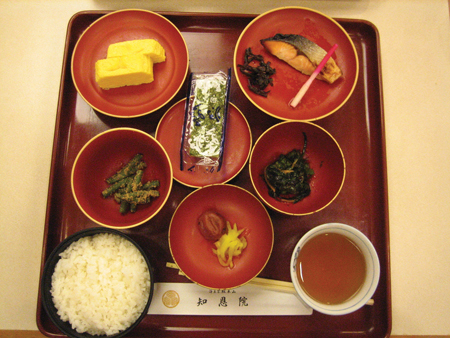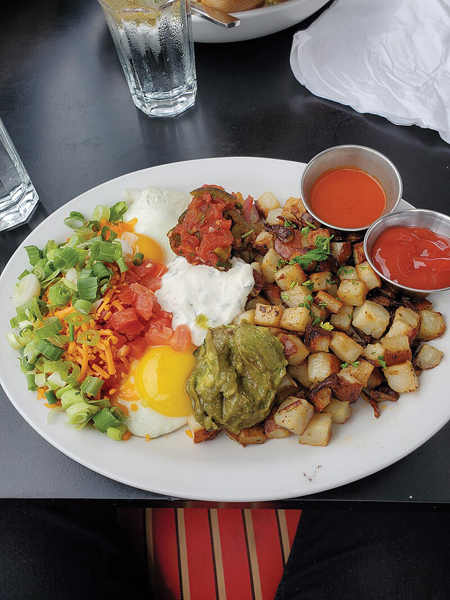Musings: Breakfast: The King of Meals

Whether you call it nashta or breakfast or petit-déjeuner or desayunoor or choshoku or tiffin, there’s no meal like the satisfying first meal of the day.
[Left] A typical South Indian breakfast or tiffin that’s savory, spicy, and sweet. (Photo Imgur)
There’s something universally spellbinding about the break of dawn, regardless of where I might travel. Lingering darkness, a gentle mist, and the somnolence of the night hide the true nature of a new place— blurring vistas and shapes of edifices, while subduing colors and smells. Then, in a matter of minutes, whether I am in Kolkata, Paris, Shanghai, or Tokyo, I find that the radiance of the rising sun takes my breath away. This is when I dream of breakfast, my favorite meal, my “passport to the rest of the day.”
After a shower I like to get out of the hotel, sit in a humble coffee shop with a cup of tea, and observe the breakfast habits of the locals. Once, seated in just such an establishment, I happened upon a used book on nutrition (whose name I can’t recall), written by Adele Davis, the acclaimed author and nutritionist of the 20th century. “Breakfast like a king,” she’d recommended, “lunch like a prince, and dine like a pauper.”
In the years that followed, I went on a quest of sorts to determine if that sage advice would apply to me. First observation: Locating a breakfast spot that offers a substantial meal is not always easy. Travel guidebooks might gush about three-star restaurants for dining, but they devote woefully little space to the first meal of the day. Second observation: In America and many European nations, breakfast is distinct from main meals, particularly in larger towns and cities, with their “in-a- rush” crowd of office workers. Dainty sweet affairs—scones, muffins, brioche, and croissants—are favored. Spicy or savory tastes are usually absent. To be offered a bowl of chili or chowder at sunrise would be unheard of.
 [Right] A traditional Japanese breakfast of rice, pickles (umeboshi and takuan), grilled salmon, egg, nori, and vegetables. (Photo Austin Keys)
[Right] A traditional Japanese breakfast of rice, pickles (umeboshi and takuan), grilled salmon, egg, nori, and vegetables. (Photo Austin Keys)
The situation is different in India. In Kolkata I grew up with a light breakfast of Darjeeling tea and fragrant buttered toast. But when I asked an uncle who lived in a smaller town nearby how he broke his fast in the morning, he replied, “But of course, with rooti-aloo.” Fragrant flat bread paired with spicy sautéed potato. “With a full warm belly, I would be ready for anything, even the ranting of my ill-tempered boss.” I must admit, though, that my favorite Indian breakfast spread comes from the South. Besides being vegetarian-friendly, the dishes confer health benefits due to the fermentation process often used in the preparation. Consider dosa (lacy-thin crepe filled with potatoes), idly (soft fluffy fermented rice-and-lentil cake), sambar (spicy lentil soup), vadas (crispy fritters), and upma (savory, rice-based cereal). “Dive into a dosa,” the saying goes in South India, “and let your day roll.”
Years later, I moved to France, but those hot, pungent tastes lingered in my mouth. At the corner café on my first day in Paris, I watched the waitress, wearing a frilly, flowery red apron, place a basket of croissants before me. Between sips of tea, I struck up a conversation with a Frenchman seated at the next table. “Breakfast isn’t a big deal for us,” he said, in an inversion of the popular wisdom delivered by Adele Davis. “Notice we call our breakfast le petit dejeuner or small lunch. I eat just a little at breakfast—usually a demi tasse of espresso and a pain au chocolat—a little more at lunch, and lots more at dinner.”
I couldn’t help but mention the spicy, savory items that were de rigueur at breakfast in South India.
“Quelle horreur,” the man replied, eyebrows raised in an eloquent expression of dismissal. “Spicy food in the morning? Not possible. Small bites—croissants—whisper ‘bon jour’ in my ears. But let me assure you that you’ll never go hungry here in the morning. Just visit our excellent patisseries.”
And visit them I did. I sampled a wide variety of pastries, including such national favorites as chausson a la pomme, pain au raisin, and baba au rhum. With them came a new, shocking insight: Light, sweet affairs, often called “slow sips and meaningful bites” lacked the nutritional value and staying power needed during the day. Another observation: In much of the world outside Europe and North America, in what is now called the Global South, the first meal of the day is likely to be heavier, more nutritious, and a preview of what might be served later. This might include a savory item, often a protein source, and one or more vegetable preparations; examples being soups, dumplings, legumes, and even fish.
 A traditional Japanese breakfast consisting of small servings of miso soup, broiled salmon, steamed rice, grated daikon, and fresh fruit is a mini version of the typical evening meal. Mexicans often greet their day with the same beans, salsas, and fresh tortillas that are standard fare at supper. Huevos (eggs) can show up at any meal there, not just at breakfast. A Malaysian friend, now living in Iowa, lamented how much she missed her favorite childhood breakfast of coconut rice and a mess of spiced greens.
A traditional Japanese breakfast consisting of small servings of miso soup, broiled salmon, steamed rice, grated daikon, and fresh fruit is a mini version of the typical evening meal. Mexicans often greet their day with the same beans, salsas, and fresh tortillas that are standard fare at supper. Huevos (eggs) can show up at any meal there, not just at breakfast. A Malaysian friend, now living in Iowa, lamented how much she missed her favorite childhood breakfast of coconut rice and a mess of spiced greens.
[Left] A Mexican breakfast that includes avocado, hash browns, and sunny side up eggs. (Photo Rohan Wankar)
In Shanghai, on a cold winter morning, guidebook in hand, I noticed that locals were lining up in front of a place. It was an establishment renowned for its noodle soup, my guidebook indicated. My curiosity piqued, I decided to go inside. Eager customers were being served large blue-and-white porcelain bowls filled with slippery noodles in a flavorful broth, a popular breakfast item here. Noodles were especially welcome in soup dishes not only because they were inexpensive, nutritious, and filling, but also because they were a traditional symbol of longevity. Furthermore, I gathered that the bowls themselves had importance beyond their utilitarian purpose. By quietly cupping their hands around the plump, round shape of the steaming bowls, the shop’s patrons were being comforted by their warmth.
Ever since, I’ve approached the first meal of the day from the same multicultural perspective as dinner. There’s one twist. Rather than following any ethnic tradition, I allow my mood and energy requirements of the day to dictate the food I select. By varying the meal, I am more likely to consume a broader set of nutrients, or so I trust.
Might Adele Davis have approved? Perhaps. One thing I can say for sure: When the freshness of dawn combines with an eclectic menu, breakfast becomes a wonder, fit for a king.
Bharti Kirchner is the author of nine novels and four cookbooks. Her most recent novel is Murder at Jaipur: A Maya Mallick Mystery. She lives in the state of Washington.
Enjoyed reading Khabar magazine? Subscribe to Khabar and get a full digital copy of this Indian-American community magazine.
blog comments powered by Disqus










